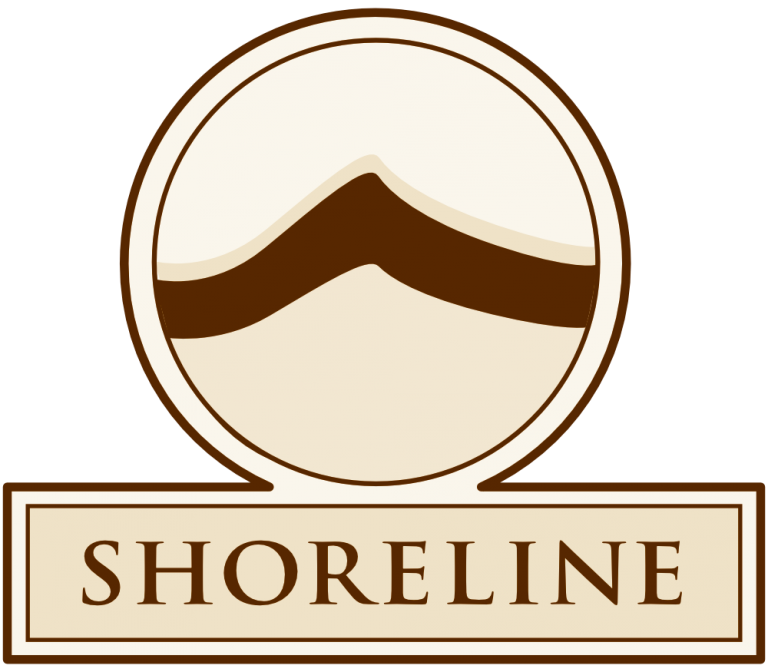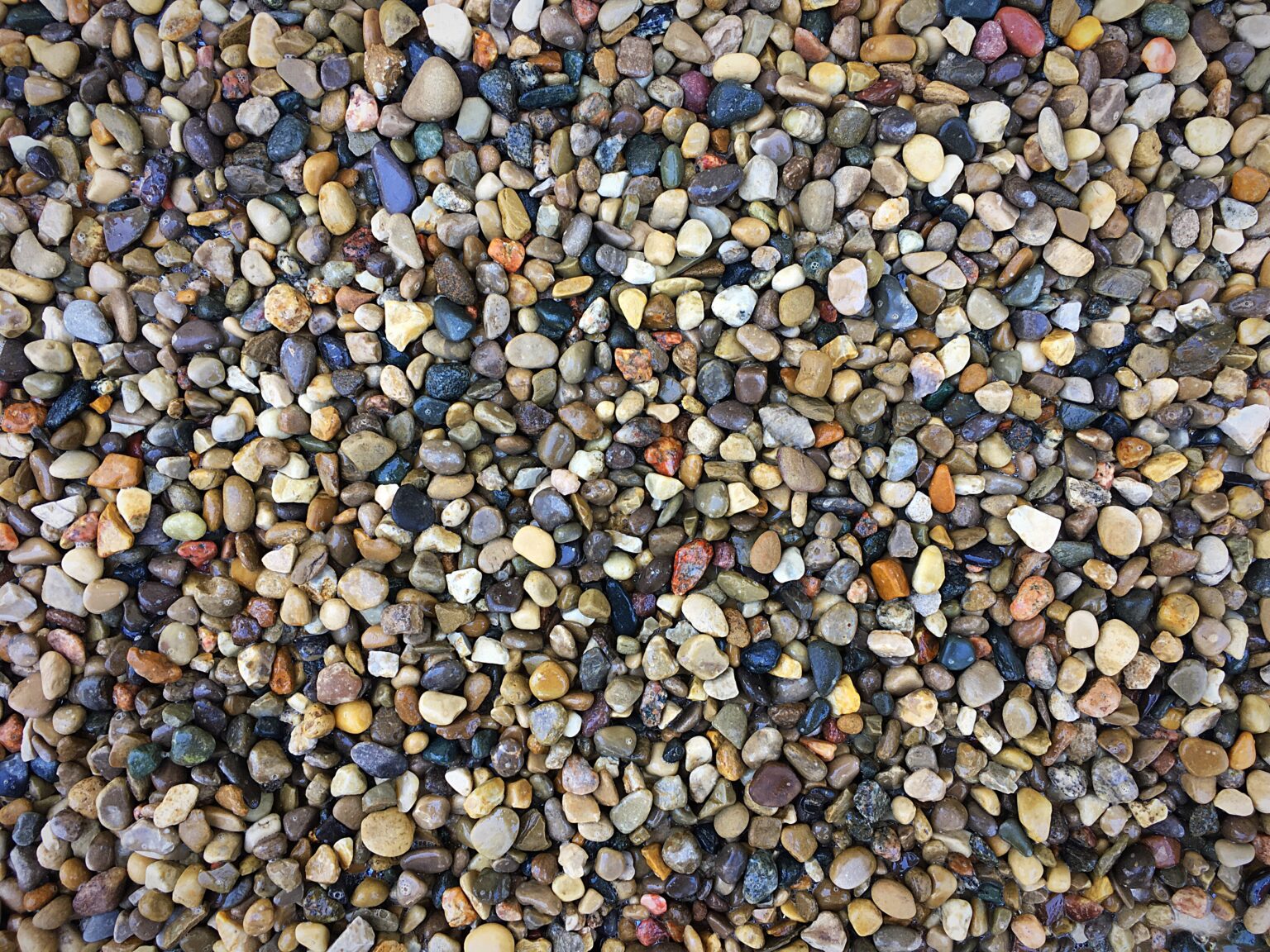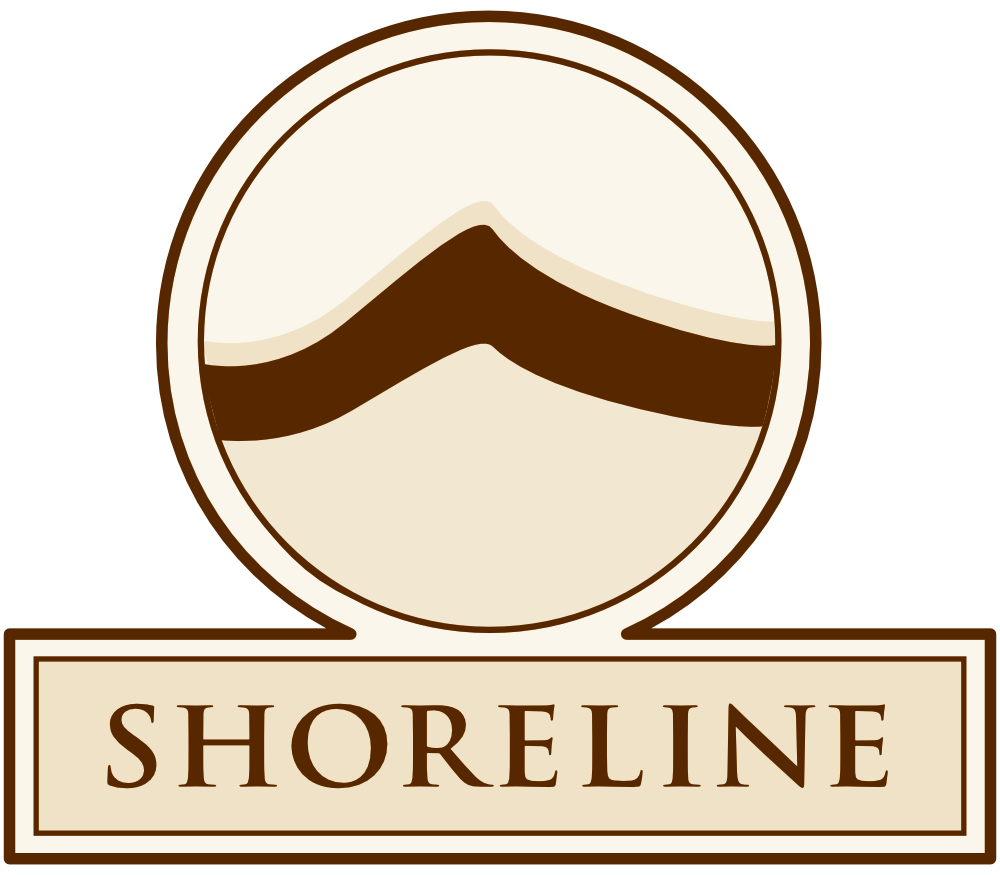Turning a commercial or shared community space into an inviting, tranquil oasis means incorporating elements of nature, from lush local plants to small Indiana pea gravel. Each Indiana pea gravel stone is unique, and together, they can be used to create beautiful entryways, landscaping, patio areas or even a driveway or parking lot.
Beautiful, versatile enough to complement any exterior theme, and fairly easy to install in your space – there’s plenty to love about pea gravel. Our Definitive Guide will teach you everything you ever wanted to know about pea gravel to help you create the ideal outdoor space.
What is Pea Gravel? The Origin of Indiana Pea Gravel
Pea gravel is the collective name for small, natural stones that have been worn away and had their hard edges softened by the flow of a river. Indiana pea gravel is a specific type of small, polished stones obtained from the White River basin. This gravel is quite small, and comes in naturally occurring shades of gray and white. The stones were thought to have been transported by ice flowing into Indiana during the Ice Age, with a matrix composed of sand and silt.
It’s referred to by many different names, such as:
- Pea rock
- Pea gravel
- Pea pebbles
- Pea stone
- Birdseye Pea Gravel
- Rice Gravel
- CM16 (this is the trade name for pea gravel, which is what you may see.)
The most popular name for these small stones is pea gravel; it gets its name from the size of the pebbles, which are usually about the same size as green peas.
What is Indiana Pea Gravel Made Of?
Pea gravel is made of hundreds or even thousands of small, smoothly rounded stones. It’s mostly used for decorative landscaping and drainage and is a popular material for mulch replacement. You may find it in all types of structural constructions that stone would be used for.
Pea gravel is made of natural stone, not man-made materials. It’s durable and could last for thousands of years.
What is Pea Gravel Used For?
Because pea gravel is small and relatively soft compared to concrete, it’s often used for outdoor walkways, such as a patio or garden path, garden border accents, or even dog runs! Some people may even prefer to have pea gravel for their driveway or for parking lots.
It’s such a versatile material that it can be used just about anywhere and is soft enough underfoot to be a great walkway material.
Pea gravel isn’t just pretty to look at, it’s also extremely useful for all manner of outdoor applications. It’s popular as a mulch alternative in larger commercial or shared spaces, as it requires less maintenance.
Function of Pea Gravel
The small stones that comprise pea gravel are the perfect size to help break up pools of standing water in your exterior lawn area, and it’s often used for drainage.
It’s also used in places that might be difficult to grow grass, so if you have trouble areas, you may wish to make a small border and fill it with decorative pea gravel. You solve your grass-growing problem and enhance your curb appeal all at the same time, creating interest in an area of your landscape that would otherwise be hard to do something with.
Cost and Colors of Pea Gravel
Pea gravel comes in all shades of gray, ivory, brown and white, but there may also be some pops of earthy red or pale green. If you have a certain idea of how you want the finished project to look, your landscaping, stone or garden center can help you find the right colors to match. Some of the most common colors of pea gravel are:
- Red
- Gray
- White
- Brown
- Green
- Yellow
For the most part, pea gravel colors tend to stay close to shades you would find in a forest or at the bottom of a mountain stream (which is probably where your pea gravel came from!).
Maintaining Your Pea Gravel Installation
When well-kept and maintained, your pea gravel installation will look lovely for years or even decades, but if you don’t take care of it, it can get messy quickly. Controlling weeds is critical to keeping the pea gravel looking nice and keeping the small pea gravel within its borders and not spreading to places you don’t want it.
You can use a commercial weed killer to zap any weeds that start growing, or you can manually weed your pea gravel paths. If you use pea gravel in a high-traffic walkway area, then you’ll have to rake periodically to cover any holes or spaces where the gravel gets thin. Over time, people walking, pets running, and children playing will cause the rocks to shift.
Installing Your Pea Gravel Landscaping Fixtures
The most important consideration for properly installing your pea gravel is to use landscape fabric underneath the area you wish to place the pea gravel. The landscape fabric will help keep the pea gravel in place and, as you place it, give you an idea of how the finished installation will look.
Landscaping fabric also significantly reduces weeds, which means much less mess and weeding for you! Before you lay the landscape fabric down, rake the soil and then even out the soil so that the gravel has a level surface to rest.
If you can find landscaping fabric staples, this will be even more helpful to keep it in place. The staples stabilize the fabric and prevent the edges from fraying, curling up, or being pulled up, especially in higher-traffic areas.
Edging for the Pea Gravel
Sturdy, decorative edging is essential to keeping pea gravel looking nice and preventing any stray stones from getting into places you don’t want them. If little pea gravel stones get into your lawn, it could be really dangerous when you mow – the gravel could fly up and hurt someone.
There are many different ways to edge your pea gravel, depending on what the rest of your exterior looks like and your budget. Most people choose materials like:
- Metal edging
- Plastic or rubber edging
- Decorative bricks
- Larger rocks
If you’re planning to use pea gravel for a walkway, then bricks or bigger rocks can be a great way to define the path. For smaller, decoration-only installations of pea gravel, then you may be able to use thinner edging material.
Be sure to create the ending a few inches above the top of the pea gravel layer to keep it all in, making a clean, crisp, line of separation.
How Can I Use Pea Gravel For Driving Surfaces?
A lovely white or beige pea gravel driveway, entrance rotunda, or parking area is an elegant-looking welcome touch to your building, no matter what style of architecture it is. But, it does require regular maintenance and upkeep to prevent the rocks from spilling into the street or lawn. Make sure that any ruts or holes are carefully raked to prevent cars from getting stuck.
The look is dramatic, though, and can boost the curb appeal of any building instantly!
One way to make sure that the gravel stays in place better (and reduces your time maintaining it) is to use a tar and chip or hot oil gravel method of installation. It works on pavement or can be used to cover an existing driveway with pea gravel. Do not use this technique on soil or grass!
This application process works like this:
- A thin layer of hot oil is laid down on the existing pavement
- The pea gravel is slowly spread onto the surface, working a small patch at a time
- Carefully rake the pea gravel so that it’s an even surface
- The initial layer of pea gravel adheres to the hot oil surface
- Apply a top layer of loose stones for a more natural, looser feel
The top layer of pea gravel also stabilizes the attached bottom layer. It’s a great alternative to completely loose gravel and can help you better maintain the pea gravel appearance of your driving surface.
The Difference Between Pea Gravel and Crushed Stone
Pea gravel is not the same as crushed stone or larger gravel. Crushed stone or rock is usually larger than pea gravel, about 3/8″ – 4″, so it’s not the same delicate size as pea gravel.
Crushed stone is also rougher, both the surface and the edges, as it has not had the benefit of water wearing down the edges as pea gravel has.
Crushed stone is best for underground projects, or places where people and pets aren’t going to be walking. You may choose to use crushed stone underneath pea gravel in areas where you need deeper drainage, but take care that weeds don’t invade the spaces between the crushed stone pieces.
Can You Use Pea Gravel for Your drainage?
Yes, pea gravel is an ideal material for drainage. It prevents water from penetrating certain areas, and the small pebbles can reduce weeds because the stones interfere with plant growth.
Pea gravel is a much better alternative than concrete, which is not a good material for proper drainage and can cause landscape-destroying surface water runoffs. Concrete patios or other large surfaces have to be supported on an incline for proper water drainage and runoff, whereas pea gravel can be used on a flat surface.
Pea gravel is also eco-friendly. Because it comes from nature, there are no by-products to creating it. It’s a naturally renewable material, and since it’s collected from the surface of the earth rather than mined from below it, collecting it is minimally invasive to the environment.
Pea gravel can be used for drainage in larger commercial areas, too. It’s very popular for mass landscaping projects and construction areas because of the permeability of the stone.
Benefits and Drawbacks of Pea Gravel at a Glance
We’ve covered a lot about pea gravel, its uses, and how to install it. So, here’s a recap of the pros and cons of pea gravel.
Pros of Pea Gravel:
- Low-cost landscaping material
- Versatile; it can be used as a base for paving stones or alone on a driving surface, patios and paths
- Easy to install
- It can be used as pest control, deterring rodent infestation from structure borders
- Improves drainage and reduces erosion
- Can prevent or reduce weed infestations
- Easy maintenance — all you need to do is rake the stones back in place
Cons of Pea Gravel
- The gravel can travel, so it needs an edging
- Can be hard to remove from the soil if you change your landscaping
- May be uncomfortable for people with sensitive feet
- Does not provide a stable base for furniture
- May need to replenish the stone every 4-5 years
- Can be hard to remove or shovel snow
Many businesses and homeowners find that the beauty of pea gravel far outweighs the drawbacks.
Where and When Not to Use Pea Gravel
Avoid placing pea gravel directly on topsoil, as it can get into the soil and lead to tripping hazards, weed growth, and a generally messy-looking area.
If you want to have a place for outdoor entertaining, cooking, and dining, avoid using pea gravel as a surface covering for this part of your yard. It may be lovely to edge your outdoor dining area with pea gravel, but because it’s not a completely level surface, it can be dangerous for grilling or sitting down to eat.
Don’t use pea gravel where you anticipate children playing, as it can move around too much and require much more upkeep than a regular pea garden walkway or outdoor space.
Are You Ready To Get Started on Your New Pea Gravel Project?
Do you think pea gravel is the right material for your new landscaping project? We can help!


